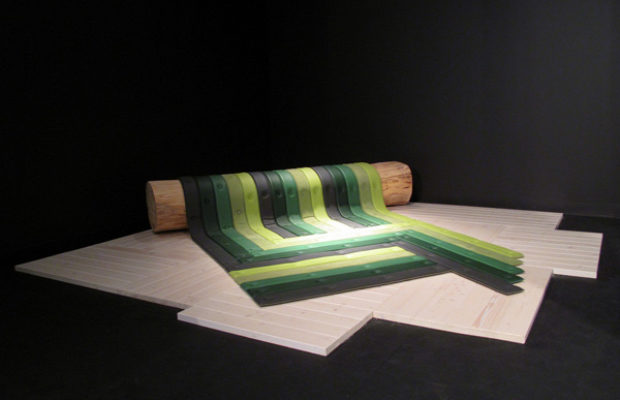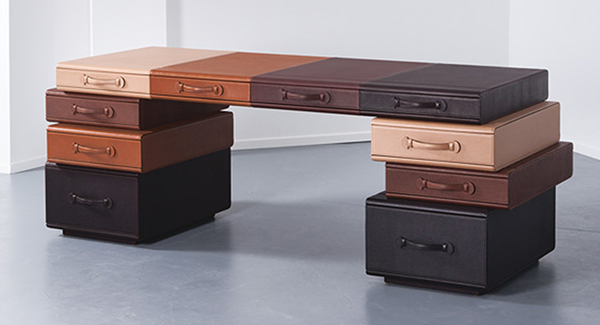 Paul Clemence Photo
Paul Clemence Photo
Design
Belgian Marvel
The Michelin three-star restaurant in the Netherlands, Oud Sluis, recently began serving diners freshly baked bread in dishes made from balloons. It’s not a trick of molecular gastronomy but the latest edition of Belgian designer Maarten De Ceulaer’s Balloon bowls, a project he debuted with the Brussels-based Victor Hunt gallery at the 2011 Salone del Mobile. Made by pouring plaster into balloons, the boldly colored, irregularly shaped bowls now share the tables at Oud Sluis with porcelain pieces by the likes of Bernardaud and JL Coquet.
It started very intuitively, like a game,” says De Ceulaer, thirty, a graduate of the Design Academy Eindhoven. “I filled a balloon with plaster and got a perfectly smooth plaster drop. Then I figured if I put a second balloon inside the first and blew it up, I could make an inside mold and an outside mold.” Once the plaster—which he pours partway into the first balloon before inserting the second one—sets, he pops the balloons to reveal concave forms that are then baked and coated for durability. The vessels, with their craggy edges and variegated hues made by food coloring swirled into the synthetic plaster mix, are at once primordial and futuristic. “The form that comes out is different every time,” the designer says, “and that’s what I like most about this project.”
Intuition is also the guiding principle behind De Ceulaer’s Mutation series of furniture, on view through August at Industry Gallery in Los Angeles. The sofas, chairs, ottomans, and side tables are composed of unique constellations of foam spheres in assorted sizes that have been applied onto structural frames. The idea originated with images of cells dividing and multiplying. “These processes fascinated me, and I wanted to build furniture that looked like that—a whole bunch of cells that might still be splitting and growing and mutating,” he says—“like you would buy a chair and in a few years it would be a sofa.”
Assembling the molecules run amok, which come in bright colors as well as basic black, is anything but scientific. “When my assistants or interns start working on a Mutation piece, they ask how to do it, but I can’t explain,” says De Ceulaer, whose five-year-old studio is located in a former brewery in Brussels. “I tell them, ‘Just do it.’ It takes a while to figure out—the pieces have to have a flow, a movement—it has to feel natural, and that’s really an art.”
“Maarten’s new Mutation series perfectly captures his design ethos,” says Craig Appelbaum, director of Industry Gallery, who showed the designer’s work at Design Days Dubai in March. “It is playful but also appeals to the emotions in its innovative use of form and material.” And De Ceulaer’s visually arresting work has been widely lauded in his home country, where Design Flanders recently presented him with its Henry van de Velde award for young talent.
Born and raised in Diest, De Ceulaer cites his “restless” nature as the reason he opted to study interior design as an undergraduate, at the Sint-Lukas Hogeschool in Brussels, rather than pursue his other interest, architecture. “It can take ten years before a building actually gets built, if at all,” he says. “And I don’t like depending on a client commissioning me to do something. With design, the nice thing is that you can just have an idea and develop it yourself.”
In turn, De Ceulaer credits his interior design training with providing him with strong spatial skills, and many aspects of his collegiate storyboards—particularly his fearless sense of color—have carried through to his industrial design career. “I work the same way with my objects as I did with spaces and interiors,” he explains. “I always try to begin from a very strong idea and then work not just to make something fancy or sleek or beautiful but something that tells a story.”
Among his earliest fans was the sharp-eyed Lidewij Edelkoort, the former chairwoman of Design Academy Eindhoven, who handpicked De Ceulaer’s work for the 2008 edition of Art Object Rotterdam. His A Pile of Suitcases prototype, a wardrobe made from leather luggage and inspired in part by his postgraduate travels abroad, caught the eye of Nina Yashar, and soon he was exhibiting a collection of Leather pieces at Yashar’s Nilufar gallery in Milan. He hung onto the prototype, and it currently stands in his bedroom.
Exhibited this spring in Paris as a joint project of Nilufar and Pierre Passebon’s Galerie du Passage, the Leather collection series—briefcases stacked into desks and dressers, suitcases piled into walls and chests—wink at the sturdy yet luxurious travel cases of Louis Vuitton and Hermès but assert their twenty-first-century identity in striking color palettes. “There’s no such thing as an ugly color. It’s a matter of finding colors that collaborate well,” De Ceulaer says, pointing to an early suitcase piece that features six shades of green, from loden to chartreuse. “I didn’t want to work in classic leather tones, like brown and maroon, so I decided on a color that was obviously contemporary and dyed, but which felt natural.” The work is simultaneously contemporary and calm, no easy task when lime green is prominent.
De Ceulaer excels at developing systems that consist of modular units—spheres, suitcases—that he deploys to create and manipulate an ever-evolving family of forms. It’s a skill that served him well when Fendi invited him to construct a project for its Design Performance series at Design Miami last December. He immediately picked up on the Italian fashion house’s history of mixing colors and materials as well as its fondness for modernism, including Bauhaus graphics and art deco flourishes. “I looked at all of those graphics and tried to come up with a system that would enable me to create any kind of pattern,” he says. “And I didn’t want to stay in two dimensions—that’s boring—but to create something that can grow over existing objects three-dimensionally.”
His Transformations series reimagined the Fendi Pequin stripe as soft planks of multicolored leather that colonized benches, covered tree stumps, and crept across a whitewashed pine floor and up the walls. “The material that inspired him was actually designed by Karl Lagerfeld when he was collecting Wiener Werkstätte—that’s what informed the stripes Maarten went on to bring into a third dimension,” says Marianne Goebl, director of Design Miami. “He created a component that could be applied to everything and it took over the space [at the fair], really bringing this pattern to life.”
It is a system that De Ceulaer is continuing to explore in his studio, which he shares with seven other creative types—four designers, two photographers, and an architect—as the Studio with a View design collective. He recently invested in some three-hundred-year-old oak beams, which he has chopped into pieces of different lengths and is transforming into furniture installations, with leather rectangles placed strategically to indicate seating areas, headrests, and backrests. “It’s something in between virtual and real—the Fendi pieces reminded people of pixels or a virtual grid imposed upon reality, or even renderings, because of the bright colors,” he says with a smile. “But if you come closer, you see the handmade nature of it. That’s what I like about it, that there are many different things to think about.”











